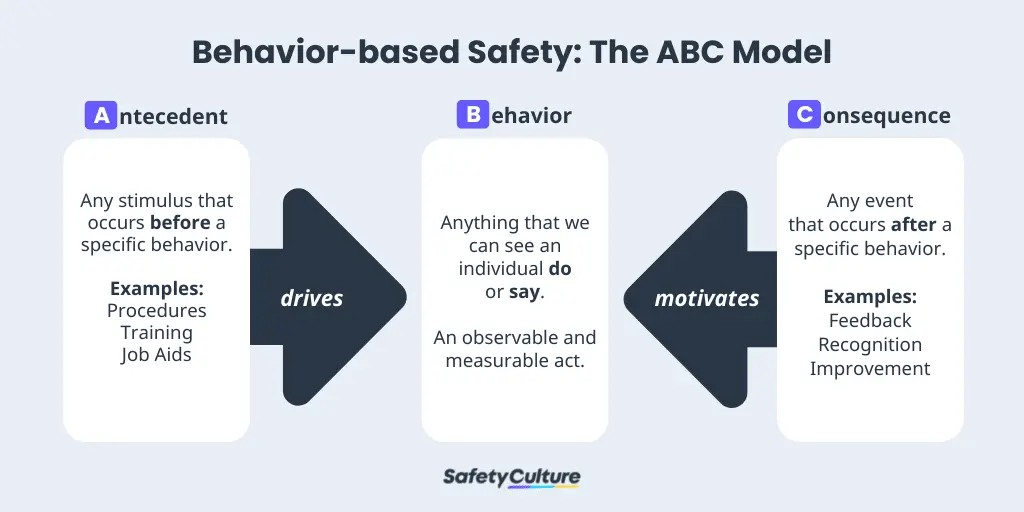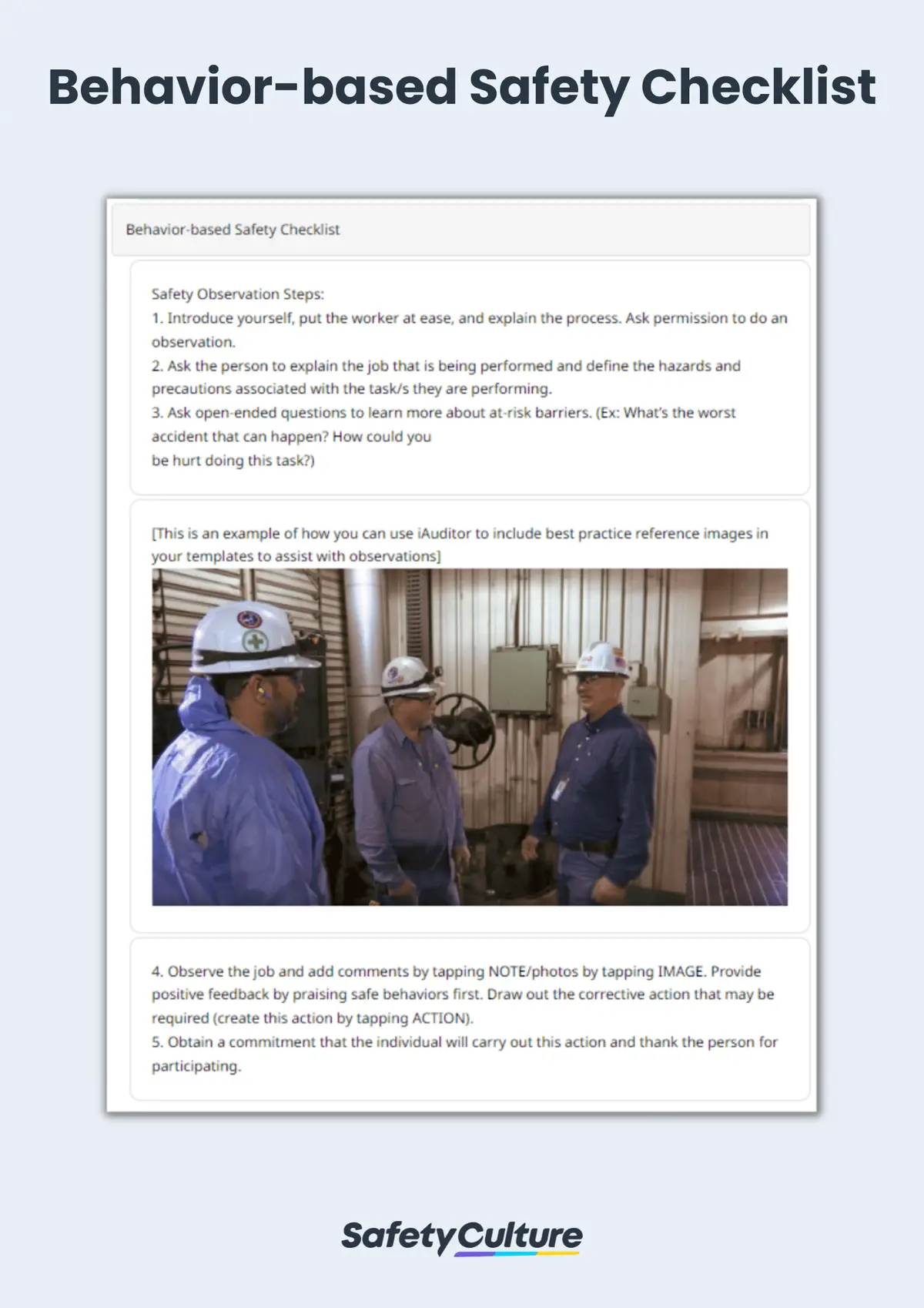What is Behavior Based Safety?
Behavior based safety (BBS) is a proactive approach to increasing safe behavior in an area. BBS focuses on reducing hazards, risks, and incidents by observing the behavior of a person and determining what follows when this behavior occurs. It involves analyzing the consequences of a particular behavior and providing proper reinforcement for a desired behavior.
Importance
Behavior based safety relies on complete trust and cooperation between the leaders and employees. Behavior based safety is important because it provides long-term solutions for eliminating risks and hazards. This life saving approach fosters a culture of safety in the workplace which is vital for lasting success. The Health and Safety Authority (HSA) discussed that organizations aim to develop a total safety culture within their area of safety. This is achieved when every employee considers safety as a value and makes sure that their fellow employees are safe. This is what the BBS approach is all about, to reduce unsafe behaviors and continuously improve on safety performances.
Behavior-based safety allows employees to be observant of their own actions, thus, improving work safety starting from themselves. It also provides an increased opportunity for leaders, managers, and employees to communicate and immediately address any potential hazards identified.
Two Main Approaches
Here are two main approaches to behavior based safety:
Micro Approach Behavior Based Safety
The micro BBS approach aims to change the behaviors of the employees that can improve safety in the workplace. Thomas Krause provided the safety improvement process that is based on the ABC model. A stands for Antecedent, B for Behavior, C for Consequences. Consequences are what follows after a behavior. Consequences can affect future behavior depending on reinforcement and feedback. The behavioral safety process includes these 7 steps:
- Identify behaviors that can be problematic such as unsafe or risky behaviors.
- Determine the root cause of the identified behaviors.
- Create possible corrective actions.
- Evaluate corrective actions.
- Develop the necessary processes to carry out the BBS program.
- Implement the BBS program.
- Evaluate the data gathered from the BBS program and check whether it solved the problem or increased safe behaviors.
Macro Approach Behavior Based Safety
The macro BBS approach aims to set permanent change in the organization’s culture. This is the total safety culture that most organizations aim to achieve with their safety programs. Michael Topf created a 6 step process that can help achieve this long-term solution for safety in the workplace. The following are the 6 steps:
- Assess and analyze the culture in the workplace.
- Teach and train every employee about behavioral based safety in a work context.
- Encourage all employees to participate in the BBS program.
- Reinforce awareness, accountability, self-observation, and self-management.
- Provide continuous support and commitment to the employees.
- Evaluate and provide feedback.
This strategy needs to be applied to all levels of the organization—self, peer, leader, and organizational—for the macro BBS approach to be effective.
What are the 7 Principles of Behavior Based Safety?
Geller stated that there are 3 factors that reflect a total safety culture—internal personal factors, external environmental factors, and behavioral factors. These factors need to be present at all times. Fundamental to BBS, the integrated approach is based upon Geller’s 7 principles. This integrated approach utilizes both individual and organizational behavior which helps achieve the total safety culture. The following are the 7 principles:
- The behavior interventions should be observable.
- Determine external factors that can help understand and improve behaviors.
- Antecedents should be used to direct behaviors while consequences should be used to motivate behavior.
- Highlight positive consequences to reinforce favorable behaviors.
- Make sure that the BBS program is measurable and objective.
- Don’t limit possibilities, create hypotheses and combine information gathered from the BBS program.
- Create a BBS program that considers employees’ feelings and attitudes.
How to Implement Behavior Based Safety in Your Workplace
Implementing behavior-based safety can seem burdensome at first, especially because in some cases, safety observations frequently end up in a blame game. Certified Safety Professional and Associate in Risk Management, Larry Hansen shared, “Behavior-based safety done right can be very effective at helping you find the core organizational causes of risk. Done wrong, it can be used to mask management failures.”
Here are 5 quick steps to help you get started with implementing behavior-based safety in your workplace:
1. Understand the ABC Model
The ABC Model, or Antecedent-Behavior-Consequence, is a well-established strategy for analyzing and potentially changing how people act. Both the management and frontline workers should clearly understand what triggers unsafe behavior and how they impact workplace safety. Follow these key concepts of the ABC Model in implementing Behavior-based Safety:

2. Examine Past Incidents and Near Misses
Assuming that employees are the problem is a misconception that leads to failure. Safety managers should carefully examine inspection results recorded over time to determine their root cause and what could have prevented reported injuries. Create a behavior-based safety checklist based on critical safe behavior such as proper PPE, body position, and equipment operation.
3. Practice Positive Reinforcement
One of the biggest mistakes in behavior-based safety is blaming the workforce for unsafe working conditions. Management should emphasize recognizing safe behavior, instead of fault-finding. When employees receive timely, specific, and positive feedback, they will pay more attention to their own and their peers’ daily safety behavior. Positive reinforcement of behavior-based safety results in behavioral changes that last.
4. Apply People-focused Interventions
Encouraging staff to take a proactive role in eliminating the root cause of unsafe acts is a step in the right direction. According to H.W. Heinrich in Industrial Accident Prevention: A Scientific Approach, underlying facts about unsafe acts include “faults of management and supervision plus the unwise methods and procedures that management and supervision fail to correct”. Conduct individual and group safety observations, coaching, and mentoring to demonstrate a commitment to open communication, fair leadership, and continuous improvement.
5. Streamline the Reporting Process
Supervisors (and workers) tend to fabricate safety observations to meet quotas and deadlines. Taking and attaching photos, drafting the report, and submitting it take too much valuable time and energy. Managing records and tracking progress can also be challenging. Organizations can easily monitor performance, improve accountability and gain visibility by successfully harnessing new technology.
What is a Behavior Based Safety Program?
A BBS program is essentially a behavioral intervention aiming to provide employees with effective feedback, reinforcement, and recognition. This program helps improve safety conditions in the workplace and increase situational awareness of the employees based on behavioral observations. HSA recommends following these 8 steps:
- Create a design team that will initiate the BBS program.
- List down targeted behaviors that are deemed unsafe. These can be taken from safety audits, near miss reports, toolbox talks and other forms that contain safety related information.
- Create a BBS checklist that can be completely filled out. Revise the checklist as needed before actual implementation.
- Determine the measurement system that can count the frequency of safe and unsafe behaviors.
- Conduct behavioral observations.
- Provide appropriate feedback depending on the behavior of the employees.
- Use the data gathered from observing employees and make necessary changes.
- Encourage employees to set achievable goals. This is the time when employees determine which behavior or process needs improvement. Remind employees to focus on the safety processes and not on the results.
Behavior Based Safety Example
A BBS checklist is an essential part of the BBS program as recommended by the HSA. Here is an example that is used during behavioral observations. This BBS checklist can determine safe and risky behaviors and also pinpoint the root cause. Follow the safety observation steps for an effective behavior audit.
Create Your Own Behavior Based Safety Checklist
Eliminate manual tasks and streamline your operations.
Get started for FREEElements
Here are the key elements of a BBS program for an effective implementation:
- Standards for behavior and performance – such as the vision, mission, priorities, policies, processes, methods, and everything involved. This needs to be communicated to everyone participating in the program.
- Resources – physical resources are the tools, equipment, money, and facilities needed for implementing a BBS system while psychosocial resources include time, training, culture, leadership, and trust.
- System of measurement – ensure that behavioral observations are measurable by creating criteria where performances can be evaluated and can be used to provide objective feedback.
- Effective consequences – this can increase favorable behaviors. Effective consequences can be in the form of positive reinforcements.
- Appropriate application – The program needs to be fair. Give recognition and reward when necessary.
- Continuous evaluation of the BBS program – this allows for the program to be constantly improved. This will also determine whether the program is effective or not.
SafetyCulture as a Behavior Based Safety System
All employees have to participate in the behavior based safety program. A digital tool such as SafetyCulture (formerly iAuditor) can efficiently collect behavioral observations of everyone in the organization. Managers and leaders can swiftly send out behavior based safety checklists to the employees without having to worry about paperwork. Other notable features:
- Thousands of free safety checklists and audit templates.
- Ability to upload media files such as photos to better capture the scene.
- Schedule a behavior audit and assign employees to fill out the BBS checklists.
- Data analytics that can reflect recurrent behaviors
FAQs About Behavior Based Safety
Every employee, from top management to operation level employees, needs to cooperate with each other in order for the behavior based safety program to be successful. Leadership influence is an important part of the plan. Managers and supervisors are in charge of promoting and creating the program while the rest of the employees have to actively participate throughout the program. It’s essentially the leaders’ responsibility to audit the behaviors and listen to the employees. They are involved in these key processes: ABC model, reinforcement, feedback, goal setting, and behavioral observations.
Behavior based safety is a safety system that works by identifying, observing, and reinforcing (positive) behaviors. It’s basically ensuring that employees are doing their tasks safely.
There are no requirements for a behavior based safety program. There is no universal guide. Organizations have to test which method is going to be effective for them. Following the 8-step guide that was mentioned earlier can be used as a foundation for the BBS program.
A behavioral safety audit, also more commonly known as a safety observation, is the process of evaluating how employees practice safe behavior in the workplace. Behavioral safety audits are usually documented in safety observation reports, where safety mentions, opportunities for improvement, and critical items are specifically identified to be shared with the workers.




